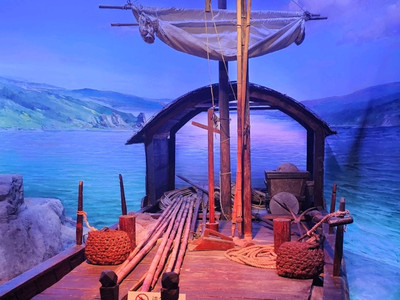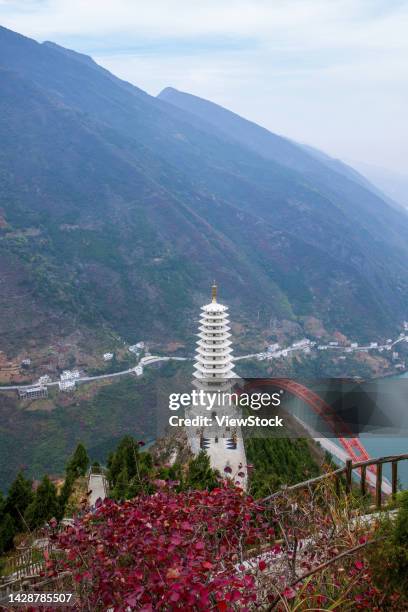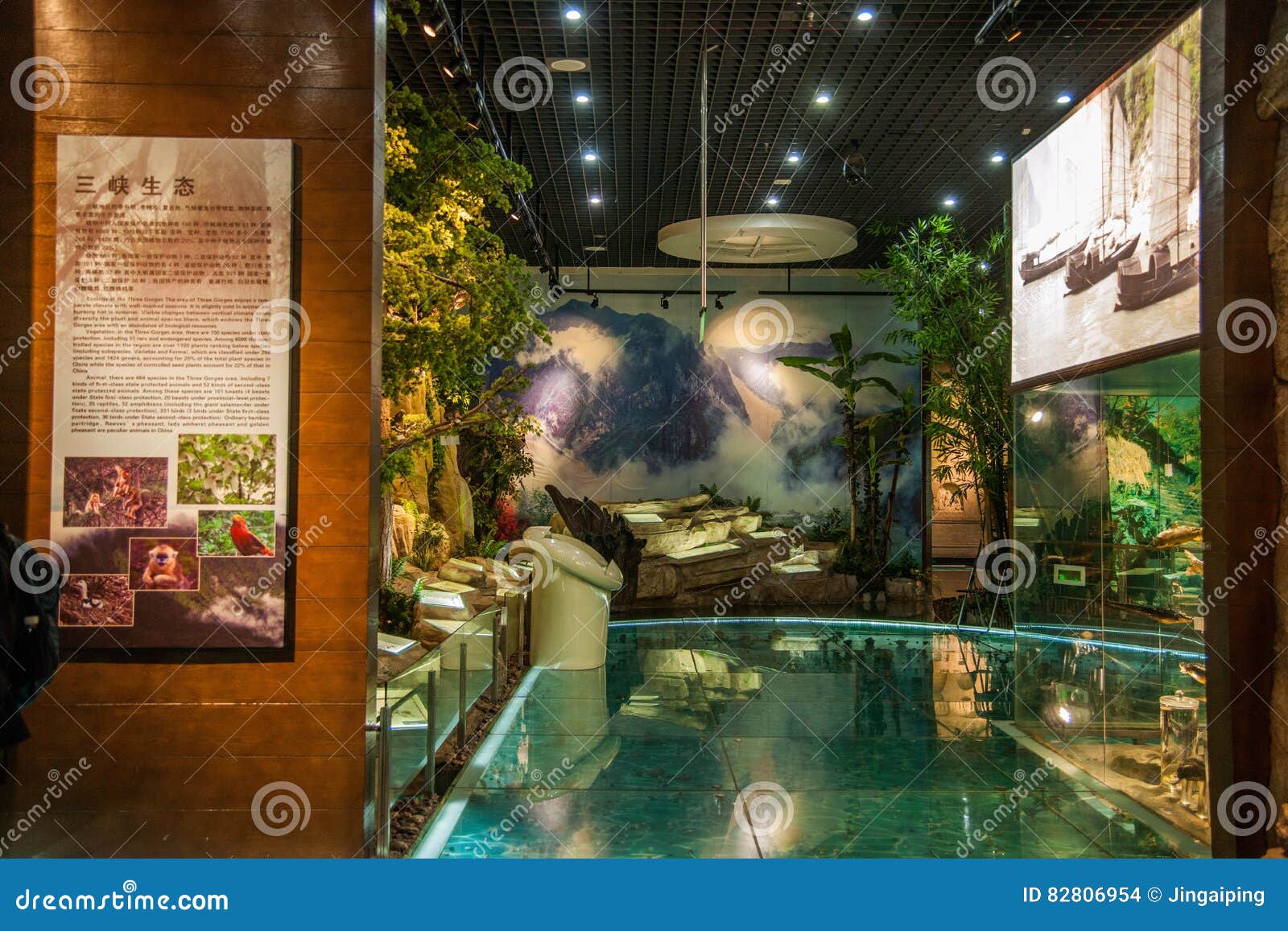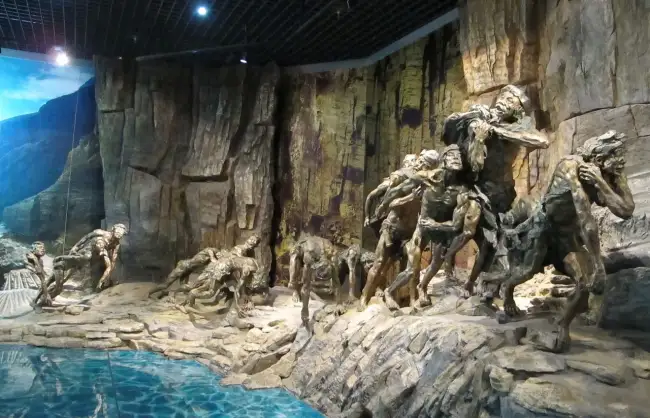Discover the Wonders of Chongqing: A Guide to the Three Gorges Museum

An Essential Guide to Visiting Chongqing_Three_Gorges_Museum
Nestled in the heart of Chongqing, the Three Gorges Museum stands as a testament to the rich tapestry of history, culture, and engineering that defines this vibrant city. As the premier destination for anyone eager to delve into the stories of the Yangtze River and the monumental Three Gorges Dam, this museum offers an immersive experience that transcends mere observation. With its striking architecture and thoughtfully curated exhibitions, the museum invites visitors to explore not only the historical significance of the region but also the profound impact of the dam on local communities and the environment.
Stepping inside, you’ll find a wealth of artifacts and displays that chronicle the evolution of Chongqing, its role in the Second Sino-Japanese War, and the engineering marvels of the Three Gorges project. Whether you’re a history buff, an engineering enthusiast, or simply curious about China’s modern transformations, the Three Gorges Museum provides an enlightening journey. Best of all, entry is free, although it’s wise to make a reservation in advance, especially for international visitors. Prepare to be captivated by the stories that shape this unique part of China, as you embark on a journey through time at one of Chongqing’s must-visit attractions.
In This Guide
- An Essential Guide to Visiting Chongqing_Three_Gorges_Museum
- The Rich History and Legends of Chongqing_Three_Gorges_Museum
- Main Highlights: What You Absolutely Can’t Miss
- Planning Your Visit: A Practical Guide
- Tickets: Prices, Booking, and Tips
- How to Get There: A Complete Transportation Guide
- Local Cuisine and Accommodation Nearby
- Frequently Asked Questions
- Final Thoughts on Your Trip
The Rich History and Legends of Chongqing_Three_Gorges_Museum
Nestled in the heart of Chongqing, the Three Gorges Museum stands as a testament to the city’s rich tapestry of history, culture, and resilience. Established in 2005, this museum was created to commemorate the monumental changes brought about by the construction of the Three Gorges Dam, one of the largest engineering feats in modern history. The museum itself is a modern architectural marvel, harmoniously blending with the natural landscape and inviting visitors to explore the depths of Chongqing’s past.
The exhibits within the museum are thoughtfully curated, showcasing the evolution of Chongqing from an ancient town to a bustling metropolis. Among the most significant displays are the artifacts that narrate the storied history of the Yangtze River and its vital role in facilitating trade and cultural exchange over centuries. Visitors can delve into the legends of the Ba and Shu kingdoms, which once thrived in this region, and understand how the mighty Yangtze shaped the lives of its people.
The museum also shines a light on Chongqing’s pivotal role during the Second Sino-Japanese War. This period was marked by immense struggle, and the museum pays homage to the heroes and events that defined this turbulent time. With photographs, personal accounts, and military artifacts, it captures the spirit of resilience that characterizes the city.
One of the highlights of the Three Gorges Museum is its emphasis on the environmental and social impacts of the Three Gorges Dam project. As visitors navigate the museum’s halls, they encounter displays that explore not only the engineering marvel itself but also the communities affected by its construction. Through interactive exhibits and multimedia presentations, the museum fosters a deeper understanding of the balancing act between progress and preservation.
For international travelers, the Three Gorges Museum offers a glimpse into the heart and soul of Chongqing. Admission is free, but it is advisable to make a reservation ahead of time. While the museum is easily accessible, be prepared to encounter some language barriers; however, the staff is generally supportive and willing to assist.
As you wander through the museum’s galleries, you will be enchanted by the legends and historical narratives that come alive. The Three Gorges Museum is not merely a repository of artifacts; it is a celebration of a city that has withstood the tests of time, embodying the spirit of innovation, resilience, and cultural richness that defines Chongqing today. Whether a history enthusiast or a curious traveler, this museum offers an enriching experience that will deepen your appreciation for this fascinating city.

Chongqing_Three_Gorges_Museum.
Main Highlights: What You Absolutely Can’t Miss
Visiting the Three Gorges Museum in Chongqing is an enriching experience that delves into the history, culture, and engineering marvels of this region. Here are the main highlights that you absolutely cannot miss during your visit:
Engaging Exhibits on the Three Gorges Project
One of the most impressive aspects of the museum is its comprehensive display on the Three Gorges Project—an engineering feat that reshaped the Yangtze River and its surroundings. The exhibits provide detailed insights into the dam’s construction, its impact on local communities, and the environmental implications. Be sure to check out the scale models and multimedia presentations that vividly illustrate the challenges faced during its development.
History of Chongqing
The museum serves as a gateway to understanding Chongqing’s rich history. Explore displays that chronicle the city’s evolution from a small town to a bustling metropolis. Highlights include artifacts from the Second Sino-Japanese War, showcasing Chongqing’s strategic role during this tumultuous period. These exhibits not only educate but also evoke a sense of pride in the resilience of the local people.
Cultural Heritage Displays
Don’t miss the sections dedicated to the cultural heritage of the Three Gorges region, including traditional clothing, music, and art. These displays highlight the unique customs and practices of the local ethnic groups, providing a well-rounded understanding of the area’s diverse cultural landscape.
The Beautiful Architecture
The museum itself is a architectural marvel, featuring stunning design that blends modern elements with traditional Chinese aesthetics. Take a moment to appreciate the beautiful landscaping surrounding the museum, which includes tranquil gardens that offer a peaceful respite from the city’s hustle and bustle.
Interactive Learning Experiences
For those traveling with family, the museum offers interactive exhibits that engage visitors of all ages. Check out the educational programs and workshops, which provide hands-on learning opportunities about the region’s history and ecology.
Temporary Exhibitions
Keep an eye out for temporary exhibitions that may be on display during your visit. These often feature unique themes related to the Three Gorges, showcasing rotating collections of artifacts and artworks that further enrich your experience.
Visitor Information
The museum is free to enter, but it’s important to note that advance reservations are required, especially for international visitors. Make sure to bring your passport for registration. The museum is open from 9:00 AM to 5:00 PM, making it easy to fit into your itinerary.
Nearby Attractions
After exploring the museum, consider visiting nearby attractions such as Jiefangbei Square and Hongya Cave, both of which complement your cultural experience in Chongqing. Delicious local cuisine can also be found in the vicinity, allowing you to savor the flavors of Sichuan.
With these highlights in mind, your visit to the Three Gorges Museum will be both memorable and insightful, offering a deep dive into the history and culture of one of China’s most pivotal regions.

Chongqing_Three_Gorges_Museum.
Planning Your Visit: A Practical Guide
Visiting the Chongqing Three Gorges Museum can be a fascinating experience, offering insights into the rich history and culture of the region, particularly in relation to the Three Gorges Dam project. Here’s everything you need to know to ensure a smooth visit.
Getting There
Situated at No. 236 Renmin Road, Yuzhong District, Chongqing, the museum is conveniently located in the heart of the city. If you’re traveling from the Chongqing Jiangbei International Airport, you can take a taxi or use ride-hailing apps, which will take approximately 30-40 minutes depending on traffic. For those using public transport, consider taking the metro to the People’s Liberation Monument Station and then walking about 15 minutes to the museum.
Opening Hours
The museum is open daily from 9:00 AM to 5:00 PM. To make the most of your visit, try to arrive early in the day to avoid crowds and have ample time to explore the exhibits.
Admission
Entry to the museum is free, but it is essential to make a reservation online, especially for international visitors. Reservations can be made through the museum’s official website, and you’ll need to present your passport upon entry. Note that there may be a small fee for certain special exhibitions, so check the website for details.
What to Expect
The Three Gorges Museum showcases a variety of exhibits focusing on the history of Chongqing, the Three Gorges area, and the construction of the Three Gorges Dam. You can expect to see artifacts, photographs, and multimedia displays that highlight the region’s cultural heritage and its significance during historical events, such as the Second Sino-Japanese War.
While many visitors appreciate the informative nature of the displays, some have noted that the exhibits could benefit from more spectacular presentations. However, you can still gain a deep understanding of the engineering marvel that is the Three Gorges Dam.
Tips for a Great Experience
- Reserve in Advance: Secure your spot online to avoid any last-minute hassles.
- Visit Early: Arriving at the museum right when it opens can help you enjoy a quieter experience.
- Check for Closures: Some exhibits may be temporarily closed, so it’s a good idea to check in advance or ask at the front desk upon arrival.
- Language Barrier: While some staff may speak limited English, it’s advisable to have a translation app handy for smoother communication.
- Plan for Nearby Attractions: After your visit, consider exploring nearby sites such as Hongya Cave or People’s Assembly Hall, both within a short distance.
Nearby Dining Options
If you’re feeling peckish after your museum visit, you’re in luck! The area surrounding the museum has a plethora of dining options. Here are a few recommendations:
- De Zhuang Hotpot: A local favorite for authentic Chongqing hotpot.
- 47 Skybar Restaurant: Offers a mix of Chinese and Western dishes with stunning views.
- Liji·Taizhou Cuisine: Known for its healthy Chinese dishes.
Conclusion
A visit to the Chongqing Three Gorges Museum is a must for anyone looking to delve into the history and culture of this unique region. By planning ahead and keeping these practical tips in mind, you can ensure a rewarding and enjoyable experience. Whether you’re fascinated by history, engineering, or simply looking for an enriching day out, this museum is a fantastic place to start.

Chongqing_Three_Gorges_Museum.
Tickets: Prices, Booking, and Tips
Visiting the Three Gorges Museum in Chongqing is a fascinating experience, offering insights into the region’s rich history and the monumental Three Gorges Dam project. Here’s everything you need to know about ticket prices, booking, and tips for a smooth visit.
Ticket Prices
Admission to the Three Gorges Museum is free of charge, making it an accessible option for all travelers. However, foreign visitors are required to pay a small entrance fee of RMB 50 (approximately $7), which contributes towards the maintenance of this cultural institution.
Booking Your Visit
Reservations are mandatory for foreign tourists, which can be conveniently made online. To book your visit, you’ll need to provide your passport information. It’s advisable to complete your reservation in advance to ensure a hassle-free entry, especially during peak tourist seasons.
Tips for a Seamless Experience
-
Plan Your Visit: The museum operates from 9:00 AM to 5:00 PM, Tuesday through Sunday. It’s closed on Mondays, so plan accordingly. Arriving early can help you avoid crowds and give you ample time to explore the exhibits.
-
Language Assistance: English-speaking staff may not be readily available, so it’s wise to learn a few basic phrases in Chinese or use translation apps to communicate effectively. The museum does have some English signage, but patience is key.
-
Security Procedures: Be prepared for security checks upon entering. It’s best to keep your belongings to a minimum to expedite the screening process.
-
Exhibit Highlights: While the museum offers a wealth of information, some visitors noted that certain exhibits could be more spectacular. However, the insights into the history of Chongqing and the engineering behind the Three Gorges Dam are invaluable.
-
Nearby Attractions: After your museum visit, consider exploring nearby attractions like Hongya Cave or Jiefangbei Square, both of which can enhance your Chongqing experience.
By following these guidelines, you’re sure to have a rewarding and enriching visit to the Three Gorges Museum, discovering the fascinating narratives that shape this vibrant region of China.
How to Get There: A Complete Transportation Guide
Getting to the Chongqing Three Gorges Museum is a journey that combines the thrill of exploring one of China’s most vibrant cities with the ease of modern transportation options. Whether you’re arriving from within China or flying in from abroad, here’s a comprehensive guide to help you navigate your way to this remarkable destination with ease.
By Air
Chongqing Jiangbei International Airport (CKG) is the primary airport serving the city and is well-connected to major cities worldwide. Upon arriving, you have several options to reach the museum located in the Yuzhong District.
- Airport Shuttle Bus:
- Take the Airport Shuttle Bus Line 3 to the city center. The bus operates from 7:00 AM to 10:00 PM, with a frequency of about 30 minutes.
-
Get off at the Jiefangbei stop, which is approximately a 15-minute walk to the museum.
-
Taxi:
-
Taxis are readily available at the airport. A direct taxi ride to the museum will take about 30 to 40 minutes, depending on traffic and will cost around 60-80 RMB.
-
Ride-Hailing Services:
- Services like Didi are widely used in Chongqing. Simply download the app, and you can request a ride directly to the museum.
By Train
If you’re traveling from other cities in China, Chongqing North Railway Station and Chongqing Railway Station are two major train hubs.
- From Chongqing North Railway Station:
-
Take Metro Line 3 towards Yuanjiagang, transfer at Jiangbei Park Station to Line 2, and continue to Jiefangbei Station. The museum is about a 20-minute walk from the station.
-
From Chongqing Railway Station:
- Take Metro Line 1 towards Daping and transfer at People’s Square Station to Line 2, then head to Jiefangbei Station. The museum is approximately a 20-minute stroll from there.
By Bus
Chongqing has an extensive bus network, making it easy to reach the museum from various parts of the city.
- Look for buses heading towards People’s Square or Jiefangbei. Popular bus routes include 104, 105, and 118.
- Once you disembark, the museum is just a short walk away.
By Metro
The Chongqing Metro system is efficient and user-friendly:
- Take Line 2 and alight at Jiefangbei Station. Exit the station and follow the signs leading you to the museum, which is about a 15-minute walk away.
- The metro operates from 6:00 AM to 11:00 PM, making it a convenient option for late-day visits.
Local Transport
Once you arrive in the vicinity of the museum, several local transport options are available:
-
Walking: The area around the museum is pedestrian-friendly. Enjoy the vibrant city atmosphere as you stroll through nearby parks and shopping areas.
-
Bicycles: Chongqing has a bicycle-sharing scheme, allowing you to rent a bike for a more leisurely approach to exploring the city.
-
Taxi or Ride-Hailing: Use local taxis or ride-hailing services like Didi to navigate through the city if you prefer not to walk.
Important Tips
- Reservations: While entrance to the Three Gorges Museum is free, it’s advisable to book your visit online, especially if you’re a foreigner, as reservations may be required.
- Language: English may not be widely spoken, so consider downloading translation apps or having your destination written in Chinese to show taxi drivers.
- Timing: The museum is open from 9:00 AM to 5:00 PM, so plan your visit accordingly to make the most of your experience.
With this transportation guide in hand, you’re all set to explore the rich history and culture housed within the Chongqing Three Gorges Museum. Enjoy your visit!

Chongqing_Three_Gorges_Museum.
Local Cuisine and Accommodation Nearby
Exploring the rich history and culture at the Three Gorges Museum in Chongqing is sure to work up an appetite. Fortunately, the area surrounding the museum boasts a vibrant culinary scene, alongside a variety of accommodation options to suit every traveler’s needs.
Local Cuisine
When it comes to dining, you can’t miss trying Chongqing’s famous hotpot, a beloved local dish that is as much an experience as it is a meal. Here are a few popular restaurants nearby:
-
De Zhuang Hotpot (德庄火锅)
Located just a short stroll from the museum, this acclaimed hotpot spot offers a wide selection of fresh ingredients and flavorful broths. The bustling atmosphere and authentic flavors make it a must-visit for any foodie. Rating: 4.1/5. -
Hong Qi Hotpot (鸿旗火锅)
Another fantastic option, this restaurant is known for its spicy broth and a wide variety of dipping options. Whether you prefer meat, seafood, or vegetables, you’ll find something to delight your palate. Rating: 4.3/5. -
Liji·Taizhou Cuisine (李记·台州菜)
For a healthier twist on local flavors, this restaurant specializes in lighter, healthier versions of traditional dishes. It’s perfect if you want to enjoy the local cuisine without the heaviness of hotpot. Rating: 5.0/5. -
Dami Xiansheng (Mr. Rice)
A cozy spot that focuses on rice-based dishes, offering a unique take on traditional Chongqing fare. The warm ambiance makes it a great place to relax after a day of exploration. Rating: 5.0/5.
Accommodation Nearby
After indulging in the local flavors, you’ll want a comfortable place to rest. Here are a few well-reviewed accommodations located within a short distance from the museum:
-
JW Marriott Hotel Chongqing
Offering luxury and comfort, this hotel features modern amenities, stunning views of the Yangtze River, and exceptional service. It’s a great choice for travelers looking for a premium experience. -
Radisson Blu Hotel Chongqing
This stylish hotel is known for its excellent location and amenities including a fitness center and multiple dining options. The contemporary design and comfortable rooms make it a popular choice among international travelers. -
Ibis Chongqing Yangjiaping
For budget-conscious travelers, this hotel provides comfortable and affordable accommodations. It’s well-connected by public transport, making it easy to explore the city after your museum visit. -
Chongqing Tsing Yi Hotel
A mid-range option that combines comfort with convenience, offering clean rooms and a friendly atmosphere. It’s a perfect base for discovering Chongqing’s rich culture and cuisine.
Whether you are looking to savor the spicy delights of hotpot or unwind in a cozy hotel, the area surrounding the Three Gorges Museum has something for everyone. Enjoy your culinary adventure and restful nights in this vibrant city!

Chongqing_Three_Gorges_Museum.
Frequently Asked Questions
Frequently Asked Questions about Chongqing Three Gorges Museum
-
What are the opening hours of the Three Gorges Museum?
The museum is open from 9:00 AM to 5:00 PM, seven days a week. It is advisable to check for any special closures or holidays before your visit. -
Is there an entrance fee for the museum?
Yes, there is an entrance fee of RMB 50 per person. However, entry is free for certain groups, such as students and seniors, but it’s best to confirm upon arrival. -
Do I need to make a reservation to visit the museum?
Yes, visitors are required to make a reservation online, especially international travelers who need to register with their passport. This ensures a smoother entry process. -
What can I expect to see at the Three Gorges Museum?
The museum features a variety of exhibits detailing the history of Chongqing, the construction of the Three Gorges Dam, and its cultural significance. While the displays are informative, some visitors suggest that more elaborate exhibits could enhance the experience. -
Are there any guided tours available?
Yes, private guided tours of the museum are available and can be arranged through local tour operators. This can provide deeper insights into the exhibits and the history of the region. -
Are there facilities for foreign visitors?
The museum has staff who can assist foreign visitors, although English-speaking services may be limited. It is recommended to bring a translation app or phrasebook if you don’t speak Chinese. -
What are some nearby attractions to visit after the museum?
The museum is conveniently located close to several attractions, including Hongya Cave, Jiefangbei Square, and Chongqing People’s Square. You can easily explore these sites on foot or via public transport. -
Is there food available nearby?
Yes, there are numerous dining options within a short walking distance from the museum. You can find a variety of local cuisine, including famous Chongqing hotpot, as well as international dining options.
Final Thoughts on Your Trip
As your journey through the Chongqing Three Gorges Museum comes to a close, you will undoubtedly carry with you a deeper appreciation for one of China’s most monumental engineering achievements and the rich tapestry of history that surrounds it. This museum is not just a collection of artifacts and exhibits; it is a portal into the past, offering insights into the resilience and ingenuity of the people of Chongqing throughout history.
While some visitors may wish for more spectacular displays, the museum’s informative nature and the stories it tells are invaluable. From the compelling narratives of the Three Gorges Dam to the historical significance of the region during pivotal moments such as the Second Sino-Japanese War, each exhibit invites reflection on the interplay of nature and human endeavor.
Leaving the museum, you may feel inspired not only by the technological marvels but also by the spirit of the people who lived through the changes brought about by these developments. As you head out to explore more of Chongqing, let the knowledge and insights gained at the museum enrich your experience of this vibrant city. Whether it’s savoring local cuisine, wandering through bustling streets, or cruising along the Yangtze River, your adventure in Chongqing is just beginning, and the echoes of history will accompany you every step of the way. Safe travels!